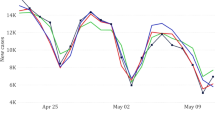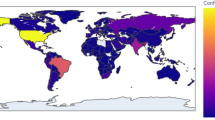Abstract
A novel coronavirus disease has emerged (later named COVID-19) and caused the world to enter a new reality, with many direct and indirect factors influencing it. Some are human-controllable (e.g. interventional policies, mobility and the vaccine); some are not (e.g. the weather). We have sought to test how a change in these human-controllable factors might influence two measures: the number of daily cases against economic impact. If applied at the right level and with up-to-date data to measure, policymakers would be able to make targeted interventions and measure their cost. This study aims to provide a predictive analytics framework to model, predict and simulate COVID-19 propagation and the socio-economic impact of interventions intended to reduce the spread of the disease such as policy and/or vaccine. It allows policymakers, government representatives and business leaders to make better-informed decisions about the potential effect of various interventions with forward-looking views via scenario planning. We have leveraged a recently launched open-source COVID-19 big data platform and used published research to find potentially relevant variables (features) and leveraged in-depth data quality checks and analytics for feature selection and predictions. An advanced machine learning pipeline has been developed armed with a self-evolving model, deployed on a modern machine learning architecture. It has high accuracy for trend prediction (back-tested with r-squared) and is augmented with interpretability for deeper insights.
Access this chapter
Tax calculation will be finalised at checkout
Purchases are for personal use only
Similar content being viewed by others
References
Gorbalenya, A.E., Baker, S.C., Baric, R.S., de Groot, R.J., Drosten, C., Gulyaeva, A.A.: The species Severe acute respiratory syndrome-related coronavirus: classifying 2019-nCoV and naming it SARS-CoV-2. Nat. Microbiol. 5(4), 536–544 (2020). https://doi.org/10.1038/s41564-020-0695-z.Medline:32123347
Liu, P., Beeler, P.: Chakrabarty RK. COVID-19 progression timeline and effectiveness of response-to-spread interventions across the United States. medRxiv (2020)
Hossain, M., et al.: The effects of border control and quarantine measures on global spread of COVID-19. In: Alvin and Zhu, **aolin and Jia,Pengfei and Wen, Tzai-Hung and Pfeiffer, Dirk and Yuan, Hsiang-Yu, The effects of border control and quarantine measures on global spread of COVID-19 (2020)
Rocha Filho, T.M., et al.: Expected impact of COVID-19 outbreak in a major metropolitan area in Brazil. medRxiv (2020)
Giordano, G., Blanchini, F., Bruno, R., Colaneri, P., Di Filippo, A., Di Matteo, A., Colaneri, M.: Modelling the COVID-19 epidemic and implementation of population-wide interventions in Italy. Nat. Med. 26(6), 855–860 (2020). https://doi.org/10.1038/s41591-020-0883-7
Shi, P., et al.: The impact of temperature and absolute humidity on the coronavirus disease 2019 (COVID-19) outbreak-evidence from China. MedRxiv (2020)
Bhattacharjee, S.: Statistical investigation of relationship between spread of coronavirus disease (COVID-19) and environmental factors based on study of four mostly affected places of China and five mostly affected places of Italy (2020). ar**v preprint ar**v:2003.11277.2020.
C3 AI COVID-19 Data Lake overview. https://c3.ai/customers/COVID-19-data-lake/, Accessed 23 Nov 2020
C3 AI COVID-19 Data Lake API Documentation. https://c3.ai/COVID-19-api-documentation/, Accessed 23 Nov 2020
IBM Weather Company Data Packages. https://www.ibm.com/products/weather-company-data-packages/, Accessed 23 Nov 2020
Corona Data Scraper COVID-19 Coronavirus Case Data. https://coronadatascraper.com/#home/, Accessed 23 Nov 2020 accessed 2020–11–23.
University of Oxford Coronavirus Government Response Tracker. https://www.bsg.ox.ac.uk/research/research-projects/coronavirus-government-response-tracker/, Accessed 23 Nov 2020
Couture, V., Dingel, J.I., Green, A.E., Handbury, J., Williams, K.R.: Measuring movement and social contact with smartphone data: a real-time application to COVID-19. Working Paper 27560, National Bureau of Economic Research (2020)
Dong, E., Du, H., Gardner, L.: An interactive web-based dashboard to track COVID-19 in real time. Lancet Infect. Dis. S1473(20), 30120–30121 (2020). https://doi.org/10.1016/S1473-3099(20)30120-1. PMID: 32087114
Economic Tracker. https://tracktherecovery.org/, Accessed 23 Nov 2020
Pedregosa, F., et al.: Scikit-learn: machine learning in python. J. Mach. Learn. Res. 12, 2825–2830 (2011)
Altmann, A., Tolo ̧si, L., Sander, O., Lengauer, T.: Permutation importance: a corrected feature importance measure. Bioinformatics 26(10), 1340–1347 (2010)
Friedman, J.: Greedy function approximation: a gradient boosting machine. Ann. Stat. 29(5), 1189–1232 (2001)
Ribeiro, M.T., Singh, S., Guestrin, C.: Model-agnostic interpretability of machine learning (2016). ar**v:1606.05386
Lundberg, S.M., Lee, S.-I.: A unified approach to interpreting model predictions. In: Proceedings of the 31st Neural Information Processing Systems (NIPS-17) (2017). ar**v:1705.07874v2
Nizolenko, L.P., Bachinsky, A.G., Bazhan, S.I.: Evaluation of influenza vaccination efficacy: a universal epidemic model. Biomed. Res. Int. 2016, 1–8 (2016). https://doi.org/10.1155/2016/5952890. PMID: 27668256
Rt COVID-19. https://rt.live/, Accessed 23 Nov 2020
Codebook for the Oxford COVID-19 Government Response Tracker. https://github.com/OxCGRT/COVID-policy-tracker/blob/master/documentation/codebook.md, Accessed 23 Nov 2020
Author information
Authors and Affiliations
Corresponding author
Editor information
Editors and Affiliations
Rights and permissions
Copyright information
© 2022 The Author(s), under exclusive license to Springer Nature Switzerland AG
About this paper
Cite this paper
Wu, H., Banerjee, R., Venkatachalam, I., Chougale, P. (2022). Impact of Interventional Policies Including Vaccine on COVID-19 Propagation and Socio-economic Factors: Predictive Model Enabling Simulations Using Machine Learning and Big Data. In: Arai, K. (eds) Intelligent Systems and Applications. IntelliSys 2021. Lecture Notes in Networks and Systems, vol 296. Springer, Cham. https://doi.org/10.1007/978-3-030-82199-9_60
Download citation
DOI: https://doi.org/10.1007/978-3-030-82199-9_60
Published:
Publisher Name: Springer, Cham
Print ISBN: 978-3-030-82198-2
Online ISBN: 978-3-030-82199-9
eBook Packages: Intelligent Technologies and RoboticsIntelligent Technologies and Robotics (R0)




